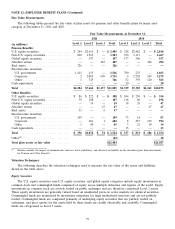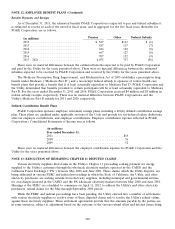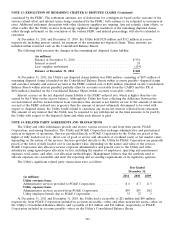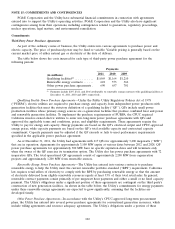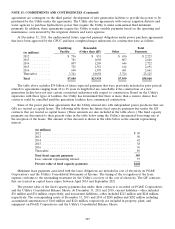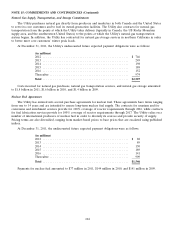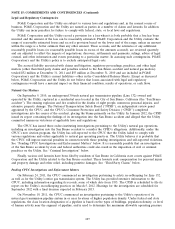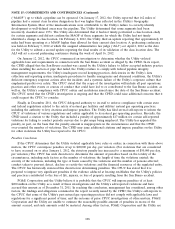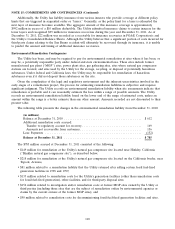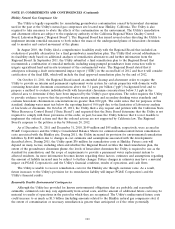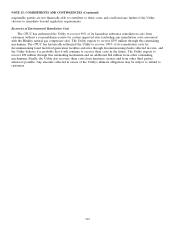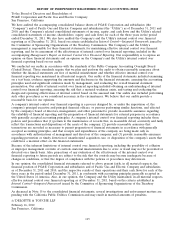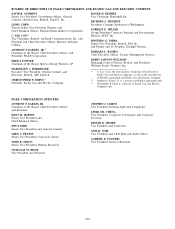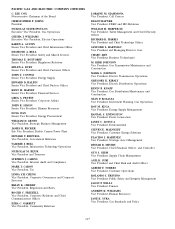PG&E 2011 Annual Report Download - page 111
Download and view the complete annual report
Please find page 111 of the 2011 PG&E annual report below. You can navigate through the pages in the report by either clicking on the pages listed below, or by using the keyword search tool below to find specific information within the annual report.NOTE 15: COMMITMENTS AND CONTINGENCIES (Continued)
Legal and Regulatory Contingencies
PG&E Corporation and the Utility are subject to various laws and regulations and, in the normal course of
business, PG&E Corporation and the Utility are named as parties in a number of claims and lawsuits. In addition,
the Utility can incur penalties for failure to comply with federal, state, or local laws and regulations.
PG&E Corporation and the Utility record a provision for a loss when it is both probable that a loss has been
incurred and the amount of the loss can be reasonably estimated. PG&E Corporation and the Utility evaluate the
range of reasonably estimated losses and record a provision based on the lower end of the range, unless an amount
within the range is a better estimate than any other amount. These accruals, and the estimates of any additional
reasonably possible losses (or reasonably possible losses in excess of the amounts accrued), are reviewed quarterly
and are adjusted to reflect the impacts of negotiations, discovery, settlements and payments, rulings, advice of legal
counsel, and other information and events pertaining to a particular matter. In assessing such contingencies, PG&E
Corporation’s and the Utility’s policy is to exclude anticipated legal costs.
The accrued liability associated with claims and litigation, regulatory proceedings, penalties, and other legal
matters (other than third-party claims and penalties related to the San Bruno accident and natural gas matters)
totaled $52 million at December 31, 2011 and $55 million at December 31, 2010 and are included in PG&E
Corporation’s and the Utility’s current liabilities—other in the Consolidated Balance Sheets. Except as discussed
below, PG&E Corporation and the Utility do not believe that losses associated with legal and regulatory
contingencies would have a material impact on their financial condition, results of operations, or cash flows.
Natural Gas Matters
On September 9, 2010, an underground 30-inch natural gas transmission pipeline (Line 132) owned and
operated by the Utility, ruptured in a residential area located in the City of San Bruno, California (the ‘‘San Bruno
accident’’). The ensuing explosion and fire resulted in the deaths of eight people, numerous personal injuries, and
extensive property damage. The National Transportation Safety Board (‘‘NTSB’’), an independent review panel
appointed by the CPUC, and the CPUC’s Consumer Protection and Safety Division (‘‘CPSD’’) completed
investigations into the causes of the accident, placing the blame primarily on the Utility. In January 2012, the CPSD
issued its report containing the findings of its investigation into the San Bruno accident and alleged that the Utility
committed numerous violations of applicable laws and regulations.
The CPUC has issued three orders instituting investigations pertaining to the Utility’s natural gas operations,
including an investigation into the San Bruno accident to consider the CPSD’s allegations. Additionally, under the
CPUC’s new citation program, the Utility has self-reported to the CPUC that the Utility failed to comply with
various regulations and orders applicable to natural gas operating practices. The Utility believes it is probable that
the CPUC will impose material penalties in connection with these pending investigations and self-reported violations.
See ‘‘Pending CPUC Investigations and Enforcement Matters’’ below. It is reasonably possible that an investigation
of the San Bruno accident by state and federal authorities could also result in the imposition of civil or criminal
penalties on the Utility. See ‘‘Criminal Investigation’’ below.
Finally, various civil lawsuits have been filed by residents of San Bruno in California state courts against PG&E
Corporation and the Utility related to the San Bruno accident. These lawsuits seek compensation for personal injury
and property damage and other relief, including punitive damages. See ‘‘Third-Party Claims’’ below.
Pending CPUC Investigations and Enforcement Matters
On February 24, 2011, the CPUC commenced an investigation pertaining to safety recordkeeping for Line 132,
as well as for the Utility’s entire gas transmission system. The Utility has provided extensive information to the
CPUC, including information regarding its records, some of which date from 1955. The CPSD is scheduled to file its
report on the Utility’s recordkeeping practices on March 5, 2012. Hearings for the investigation are scheduled for
September 2012 with a final decision expected in February 2013.
On November 10, 2011, the CPUC commenced an investigation pertaining to the Utility’s operation of its
natural gas transmission pipeline system in or near locations of higher population density. Under federal and state
regulations, the class location designation of a pipeline is based on the types of buildings, population density, or level
of human activity near the segment of pipeline, and is used to determine the maximum allowable operating pressure
107


